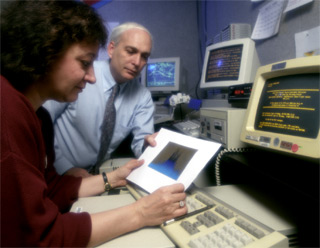Reviewing Data From the Burst and Transient Source Experiment (BATSE): Dr. Gerald Fishman (Marshall Space Flight Center), and his colleague Dr. Chryssa Kouveliotou (Universities Space Research Associates) review data from the the Burst and Transient Source Experiment (BATSE). Dr. Fishman was the Principal Investigator of the BATSE instrument, aboard the Compton Gamma-Ray Observatory's (CGRO).
Credit: NASA/MSFC
After all these years, although my research has expanded in many areas, I'm still working on gamma-ray bursts. They still intrigue me just like those falling stars did when I was a child. I've always loved to look at the Universe, at how nature expresses itself. I live for the unexpected joy of finding new things, solving mysteries, and understanding the world. And each time I learn something new, I realize how little I know!
But I do know this: No matter what obstacles are placed in your way, follow your dreams and they will take you to the stars.
As an astrophysicist, I have accomplished the goal set as a young girl under the starry night sky: I can see so much of space without leaving Earth, beyond what I ever expected. The “short” life of gamma-ray astronomy is full of surprise discoveries, which are often accomplished by young scientists. Today I have a new challenge for you, “Who will be first to see the birth of our Universe?”


